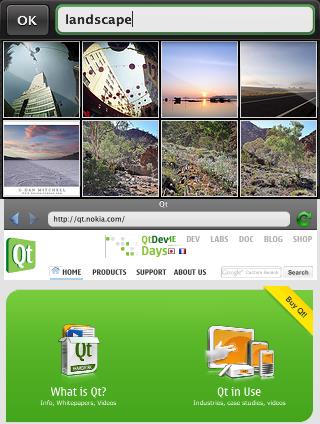QML, interface description language
Qt Markup Langue is a declarative user interface language. It is compatible with the Qt framework and interacts with its API. It can be extended with C code containing calls to this API.
To use it, the Qt declaration execution time is added to the Qt execution time.

QML Demo Gallery and Browser
Why use QML
?Creating an interface for Qt is easier with QML, as it is easier to describe a Java interface with JavaFX that is similar (while other platforms have chosen XML-derived code, such as XAML).
Enough instruction to show "Hello World!" versus seven with Qt, as we see in the list of "Hello World!" in all languages.
However, processing can be much slower than when using direct calls to Qt framework functions, and the language is also better suited for small applications with a simple interface and less for heavier applications. You can also use QML during development and then optimize the target application by moving it to Qt if it is too slow.
It is generally recommended to use QML for mobile devices and QT only on the desktop, without reducing the boot time with QML.
According to the editor, since runtime is installed on the server, the QML application can run on the Web with HTTP, which makes it an alternative to HTML. You can also create an HTML page that appears in your browser and works with JavaScript .
QML has JSON syntax, not XML
Choosing C-inspired syntax allows you to process files faster and reduce size. This is also the JSON principle.
- The objects are described as structures C.
- When returning to a string (as in JavaScript/Script/Go), there is no comma at the end of the statement.
- An object can be defined by a combination of other objects .
- Object property values can be JavaScript expressions. This allows you to associate a list of action conditions with a property .
- Status, Transition, Animation are frames associated with graphical objects (for example, Image, Rectangle, Text, etc.).
- State is a named declaration describing a set of properties that is applied to a graphical object when a condition is met.
- A transition is a declaration that spreads change over time.
- The animation describes the evolution of an object from changing its properties .
Code examples
Drow has a rectangle with the words "Hello world!"
Rectangle {
width: 200
height: 200
color: mouse.pressed ? "blue" : "red"
Text {
text: "Salut le Monde!"
anchors.centerIn: parent
}
}
Enable JavaScript...
Rectangle {
function calculateHeight()
{
... calculs...
return x;
}
height: calculateHeight()
width: {
if (height > 100) 200; else 50
}
}
Learn more at Qt. On the qt-project.org you can find a demonstration showing how to implement the browser interface in QML, with all the necessary widgets.